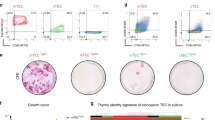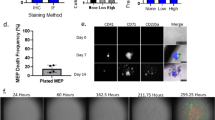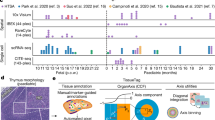Abstract
Thymocytes develop from a committed haematopoietic progenitor, referred to as a prothymocyte1–4. They are uniquely capable of migrating to and restoring the thymus of a lethally irradiated host, a property which has been exploited as a specific assay for these cells4–6. Like other committed haematopoietic progenitors, prothymocytes are found only in small numbers in even the richest sources (0.05–1.0% of the nucleated cells in bone marrow). Purification has proved difficult both in terms of finding a suitable starting material and in the degree of enrichment achieved7,8. We now report the isolation of cloned lines of cells with some of the serological and functional properties of prothymocytes. One of these lines has been in continuous culture for almost 2 years. When injected into irradiated recipients, cells from this line migrate to the thymus and there develop into cells which resemble normal cortical thymocytes.
This is a preview of subscription content, access via your institution
Access options
Subscribe to this journal
Receive 51 print issues and online access
$199.00 per year
only $3.90 per issue
Buy this article
- Purchase on SpringerLink
- Instant access to full article PDF
Prices may be subject to local taxes which are calculated during checkout
Similar content being viewed by others
References
Ford, C. E. et al. Ann. N.Y. Acad. Sci. 129, 283–296 (1966).
Basch, R. S. & Kadish, J. L. J. exp. Med. 145, 405–419 (1977).
Komuro, K. & Boyse, E. A. J. exp. Med. 138, 479–482 (1973).
Kadish, J. L. & Basch, R. A. J. exp. Med. 143, 1082–1099 (1976).
Boersma, W. et al. Cell Tissue Kinet. 14, 179–196 (1981).
Lepault, F. & Weissman, I. L. Nature 293, 151–154 (1981).
Basch, R. S., Kadish, J. L. & Goldstein, G. J. exp. Med. 147, 1843–1848 (1978).
Greiner, D. L., Goldschneider, I. & Barton, R. W. J. exp. Med. 156, 1448–1460 (1982).
Ihle, J., Keller, N., Henderson, L., Klein, C. & Palaszynski, E. J. Immun. 129, 2431 (1982).
Mathieson, B. J. & Fowlkes, B. J. Immun. Rev. 82, 141–173 (1984).
Scollay, R. & Shortman, K. Thymus 5, 245–295 (1983).
Goldschneider, I. et al. Proc. natn. Acad. Sci. U.S.A. 78, 2469–2473 (1981).
Born, W. et al. Proc. natn. Acad. Sci. U.S.A. 82, 2925–2929 (1985).
Chervenak, R., Moorehead, J. W. & Cohen, J. H. J. Immun. 134, 695–698 (1985).
Katsura, Y. et al. J. Immun. 135, 3021–3027 (1985).
Lesley, J., Hyman, R. & Schulte, R. Cell. Immun. 91, 397–403 (1985).
Loor, F. & Roelants, G. E. Ann. N.Y. Acad. Sci. 254, 226–240 (1975).
Basch, R. S. & Berman, J. W. Eur. J. Immun. 12, 359–364 (1982).
Tung, J. S. et al. Immunogenetics 14, 101–106 (1981).
Dialynas, D. P. et al. Immun. Rev. 74, 29–56 (1983).
MacDonald, H. R. Expl cell Biol. 52, 2 (1984).
Effros, R. B. & Walford, R. L. Hum. Immun. 9, 49–56 (1984).
Land, H., Parada, L. F. & Weinberg, R. A. Nature 304, 596–602 (1983).
Cairns, J. & Logan, J. Nature 304, 582–583 (1983).
Ledbetter, J. A. & Herzenberg, L. A. Immun. Rev. 47, 63–90 (1979).
Shen, F. W. in Monoclonal Antibodies and T-cell Hybridomas; Perspective and Technical Advances (eds Hammerling, G., Hammerling, V. & Kearney, J. F.) 25–31 (1951).
Bhattacharya, A., Dorf, M. E. & Springer, T. A. J. Immun. 127, 2488–2492 (1981).
Bernstein, I. D., Tarm, M. R. & Nowinski, R. C. Science 207, 68–71 (1980).
Lynes, M. A., Tonkonogy, S. & Flaherty, L. J. Immunology 129, 928–930 (1982).
Berman, J. W. & Basch, R. S. J. immun. Meth. 36, 335–338 (1980).
Goldschneider, I., Komschlies, K. L. & Greiner, D. L. J. exp. Med. 163, 1 (1986).
Author information
Authors and Affiliations
Rights and permissions
About this article
Cite this article
Goodwin, L., Rocha, A. & Basch, R. Isolation of cell lines possessing functional and serological properties resembling those of thymocyte precursors. Nature 323, 166–169 (1986). https://doi.org/10.1038/323166a0
Received:
Accepted:
Issue date:
DOI: https://doi.org/10.1038/323166a0
This article is cited by
-
Molecular biological definition of the prothymocyte: Problems of commitment and lineage promiscuity
Immunologic Research (1987)



